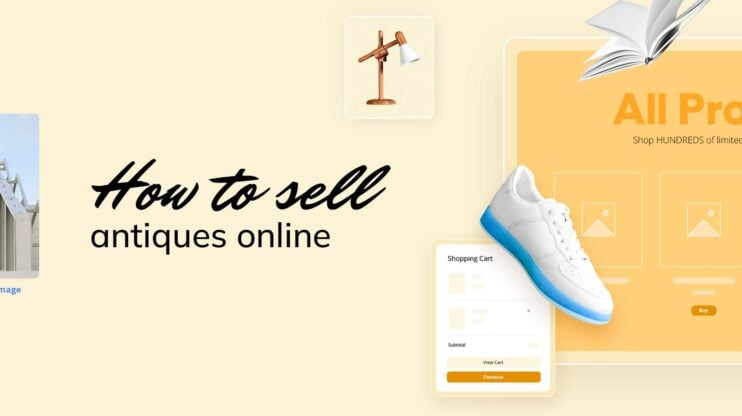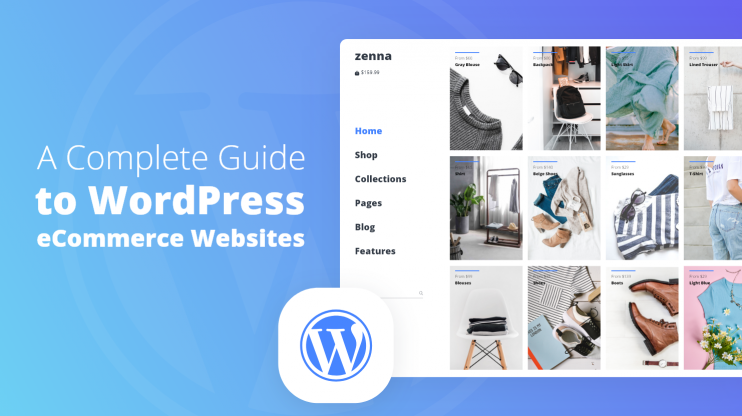Starting an online cosmetics store is a fantastic way to turn your passion for beauty into a business. A friend of mine began small, selling handmade skincare products. She used social media to connect with her audience, sharing tips and building trust. Once she started to sell some products, she expanded her product line to include all types of cosmetics. It wasn’t always easy, but her dedication paid off. If she can do it, so can you!
If you’re ready to learn how to sell cosmetics online, this guide has you covered! You’ll learn how to explore market trends, create your brand’s identity, and how to market like a pro using social media and influencers. Plus, I’ll share basic tips on creating a website that’s easy to use and some smart pricing strategies.

Create your online store in minutes!
Looking to sell online? Develop and launch your store with 10Web AI Ecommerce Website Builder.
Current online cosmetics market
I get it—selling cosmetics online can feel tricky at first. But once you take the time to understand the market and what your audience wants, you’ll be able to craft a strategy that sets you up for success.
Before doing anything else, it is necessary to figure out what cosmetic products you should enter the market with. So, let me guide you through this process.
Choosing what products to sell
Cosmetic products are basically the go-to items we use to care for our skin, hair, and appearance. Think moisturizers, shampoos, makeup, perfumes, and even hygiene products—pretty much anything that helps us feel clean, fresh, and a little more put-together.
So, a good first step in your research is to check out the market and see how different types of products are performing. Then, you can decide which ones to focus on.
Fun fact: Skincare makes up a whopping 42% of the global cosmetics market, so it’s a strong contender to start with—it’s the biggest slice of the pie compared to haircare, makeup, or fragrance. The haircare market is expected to grow at a steady 2.8% annual rate over the next four years. This makes it a promising revenue opportunity for any cosmetics brand looking to tap into the market.
When you look at numbers like these, it’s easier to spot what people are really looking for—and where the profits are hiding. With the right data and numbers, you can focus on the products people are most excited about and step into the market with confidence, knowing you’re on the path to success.
Trends within the cosmetics industry
Now that you’ve done some basic research and checked out the data on the cosmetics market, you might already have an inkling on what you want to sell. So, it’s time to dig into the trends in each category: let’s look at skincare and haircare as these two have the most potential for success, especially if you’re new to the industry.
Skincare
Skincare shoppers have some priorities: hydration, anti-aging, sun protection, and clean beauty. These aren’t just nice-to-haves—they’re essentials for any product line. Here’s what they’re loving:
- Moisturizers and serums
- Retinol creams and collagen boosters
- Lightweight, high-SPF sunscreens
- Organic and clean beauty products
And if you’re like me, you probably check for a few key things before picking a product—and it turns out most people do too! A recent study shows that 54% of consumers actively look for products labeled as environmentally friendly. Along with sustainability, customers care about ingredients like Vitamin C for brightening, niacinamide for soothing redness, or peptides for firming. They also value brand transparency, where companies openly share everything from ingredients to packaging details.
But that’s not all – skincare trends are evolving, and here are two worth noting:
- Multi-functional products: Let’s be real—who doesn’t love cutting down on steps in their routine? Products that multitask, like a moisturizer with built-in SPF or a cleanser that doubles as a toner. These are what people are searching for because they reduce the time it takes to complete their skincare routine.
- Personalization and technology: AI is taking skincare to the next level, with 75% of customers willing to pay more for tailored experiences. Big brands like L’Oréal are already on it, using AI tools like virtual try-ons and smart mirrors to help customers find products that perfectly match their skin’s needs.
Haircare
Haircare shoppers are all about keeping their hair healthy, strong, and beautiful, and their choices reflect that. They love products that focus on scalp health, repair damage, and offer personalized solutions. Here are the most demanded products in the hair care industry:
- Shampoos and conditioners
- Hair masks and treatments
- Scalp care products
- Natural and organic options
Just like with skincare, haircare shoppers are selective about what goes into their products and how they’re made. Here’s what matters most to them:
- Ingredients: People favor formulas free of parabens, sulfates, and harsh chemicals, with natural options like argan oil, aloe vera, and biotin topping the list.
- Sustainability: Eco-friendly packaging and cruelty-free certifications are influencing purchase decisions.
- Transparency: Shoppers trust brands that clearly share information about ingredients, sourcing, and production practices.
Haircare trends are also shifting, and there are some exciting ones shaping the market right now:
- Skinification of hair: Haircare is borrowing ideas from skincare, with ingredients like hyaluronic acid and niacinamide making their way into products to improve scalp health and strengthen hair.
- Low-maintenance styles: As more people lean into effortless routines, products for air-drying, heat-free styling, and quick fixes are becoming highly demanded.
These trends show a clear move toward what people are demanding: sustainability, simplicity, and smart solutions. So, whatever category you decide to enter the market with, be sure to research the current trends to achieve success.
Build your brand identity
Remember my friend who started with handmade skincare products? One of the first things she did to stand out in the beauty market was to focus on building a strong brand identity – and trust me, it was a journey. From figuring out her logo colors to refining her packaging and products, she learned that every detail made a difference. Some ideas worked, some didn’t, but each brought her closer to creating the brand that truly connected with her customers. Let’s dive into how you can do the same, one step at a time.
Choose a brand name and logo
Your brand name is one of the first things people notice, so it needs to be memorable, unique, and a true reflection of your products. Think about what your brand stands for—are you all about luxury, sustainability, or fun? Let those values guide your brainstorming. Try to keep it short and easy to say (and spell!). A name that sticks in people’s minds will make it easier for them to find you later.
Next, design a logo that will be the face of your brand—it’s what people will remember and connect with your products. So, make it simple, eye-catching, and something that truly reflects your brand’s vibe. Start by brainstorming ideas that align with your mission. What colors and fonts feel like “you”?
You can also use 10Web’s Business Name Generator to spark ideas and check if the name is available. Once you describe your business, the tool will give you a couple of options to choose from and will even take it a step further by designing corresponding logos to each. It also helps you see if a matching domain name is available, making it easier when it’s time to create your ecommerce website.
Finally, test your favorite options with friends or potential customers to see which one resonates the most. The right name can set the tone for your brand and help you make a strong first impression.
Pro tip: before finalizing your logo, show it to a small group for feedback. What clicks? What feels off? A little input can go a long way in making it perfect. A great logo builds trust and recognition, which are gold when it comes to selling cosmetics online.
Create packaging that wows
Packaging is the first thing your customers will actually hold in their hands. Beyond looking good, it should reflect your brand’s identity and values. Whether it’s sleek and modern or fun and bold, choose designs and materials that speak to your audience.
Functionality matters too! Your packaging should protect the product and be easy to use—think pumps for serums or resealable caps for creams. Bonus points if you use sustainable materials like recycled cardboard or glass, as shoppers love brands that care about the planet.
Craft your unique selling proposition (USP)
Since you already know what your audience values—whether it’s sustainability, luxury, or unique solutions—it’s time to use that insight to craft your USP.
Think about what your brand brings to the table that others don’t. Are your products made with eco-friendly ingredients? Do they solve a problem no one else is addressing? Take those strengths and turn them into a clear, compelling statement that sums up what makes your brand special.
For example: “Personalized skincare solutions made to match your unique needs”
This statement will become your guiding star, showing up on your website, packaging, and social media to remind customers why they should choose you every time. If you’re stuck on coming up with a statement, you can use 10Web’s Slogan Generator where you’ll need to describe your business and the AI will create a catchy slogan for your business.

Create your online store in minutes!
Looking to sell online? Develop and launch your store with 10Web AI Ecommerce Website Builder.
Write a business plan
The next step is to put your ideas into action with a business plan. Think of this as your roadmap—it helps you set clear goals and figure out how to get there. Let’s break it down:
- Executive summary: This is the elevator pitch for your brand. Highlight your mission, vision, and USP to give a clear picture of what your business stands for. This snapshot will help you stay focused and communicate your goals to potential partners or investors.
- Market analysis: Get to know the beauty market inside and out. Research your competitors to see what works for them and, more importantly, identify gaps you can fill. Understanding your target audience—their needs, preferences, and buying habits—is key to creating products they’ll love.
- Product line: Detail the products you’ll offer, including their ingredients, benefits, and who they’re designed for. Think about what sets them apart, whether it’s natural ingredients, innovative formulas, or sustainable packaging. The more clarity you have here, the stronger your positioning will be.
- Marketing strategy: Decide how you’ll spread the word about your brand. Social media, influencer partnerships, email marketing—choose the platforms where your audience spends their time and create engaging content to connect with them.
- Sales strategy: Outline where and how you’ll sell your products. Whether it’s your own website or other platforms, make it easy for customers to find you.
- Financial plan: This is where you budget and set financial goals. Include costs for production, marketing, and shipping, as well as your expected revenue.
- Operations plan: Think about how your business will run day-to-day. Who will manage inventory, fulfill orders, and handle customer service? A solid operations plan guarantees everything runs smoothly as your business grows.
These steps will help you have a clear, actionable plan to turn to when you’re trying to make your cosmetics business a successful one.
Finding the right platform
You have plenty of platform options to sell your cosmetics online, but choosing the right one can make a huge difference in reaching your ideal audience. Each platform has its own perks, so let’s break them down:
- Your own website: Having your own cosmetics website gives you full control over your brand. It’s your space to tell your story, showcase your products, and build a loyal customer base. Plus, you don’t have to worry about competing sellers or platform fees cutting into your profits.
- Amazon: With millions of active shoppers, Amazon is perfect for getting your products in front of a large audience. With its fast shipping and solid reputation, it’s no surprise that buyers love it—making it a great choice if you’re looking to grow quickly.
- eBay: If your products are unique, home-made, or hard-to-find, eBay can be your go-to platform. It’s where people go to hunt for those niche items they can’t find elsewhere.
- Social media (Instagram, Facebook, TikTok): Platforms like Instagram and Facebook are amazing for connecting directly with customers. These platforms are perfect for showing off your products with posts, stories, or ads. If you’re hoping to go viral or connect with a younger audience, TikTok is the way to go.
- Dedicated beauty platforms (Sephora, Ulta Beauty): If you’re targeting dedicated beauty lovers, listing your products on Sephora or Ulta Beauty is a great choice. Shoppers on these platforms are already looking to discover and buy beauty products, so your audience is right there waiting.
Each platform serves a different purpose, so it’s worth thinking about where your audience is most likely to shop. Focusing on a single platform or combining several can make a big difference—so, based on your research, choose the most fitted platform and start selling cosmetics online.

Create your online store in minutes!
Looking to sell online? Develop and launch your store with 10Web AI Ecommerce Website Builder.
Setting up your online presence
Setting up your online store might sound overwhelming at first, but it’s much easier than it seems. With user-friendly platforms and customizable tools available today, you can create a professional and inviting store without needing advanced technical skills. A little planning and the right setup will have you ready to showcase your products in no time.
Choosing the right ecommerce platform
It’s important to pick an ecommerce store that supports your goals as it will represent your business to your customers. Here are a few things to consider:
- Features that matter: Look for tools that make running your store easier, like inventory management, secure payment options, and a design that works well on mobile devices.
- Costs and fees: Check for any transaction fees or additional charges, so you know exactly what to expect.
- Personalization options: Make sure the platform allows you to customize your store to reflect your brand’s style, from colors and layouts to features that enhance the shopping experience.
Creating your cosmetics store with 10Web
Many entrepreneurs have started with a simple idea and, with the right tools, built websites that beautifully represent their brand. By focusing on design, functionality, and customer experience, they’ve managed to connect with audiences, grow their reach, and make their products shine online.
With the help of AI-driven tools and intuitive platforms– like 10Web– creating a website is easy and it’s a chance to showcase the heart of your business while leaving a lasting impression on your customers. Here’s the steps you can take to start creating your online presence:
- Head to the 10Web AI Website Builder and type in a brief description of your business. Then, click Generate Your Website to begin—it’s that simple.
- Enter your company name and refine the description if needed. This step guarantees your website reflects your brand’s identity right from the start.
- Think about how you’d like to organize your products. Whether it’s skincare, makeup, or haircare, add your categories and let AI take care of creating a clear structure.
- Review the website structure suggested by 10Web and make any adjustments. The great thing is, you can always customize it further as your store evolves.
- Choose colors, fonts, and styles that match your brand’s look and feel. This is your chance to give your store that extra touch of personality.
- Once you’re happy with everything, hit Generate, and in just a couple of seconds, you’ll have a beautifully designed, ready-to-use website.
Marketing and customer relations
Marketing is about showing off your products and creating connections that turn people into loyal customers. Here’s what you can do to get started:
- Use social media: Share tutorials, tips, and behind-the-scenes content on different platforms. You can also try to engage with your followers through polls, Q&As, and live sessions to build trust and community.
- Collaborate with influencers: Team up with influencers who genuinely love your cosmetics products and share your brand values. Their authentic reviews and tutorials can help introduce your cosmetics to new audiences in a way that feels natural. In fact, back in 2019, 66% of customers discovered cosmetic brands on social media thanks to influencer endorsements—it really works.
- Optimize your website for SEO: Use keywords people are searching for in your product descriptions and blogs to help your site stand out. A fast, mobile-friendly website makes it even easier for customers to find (and love) your brand.
- Follow beauty trends: Tools like Google Trends can show you what’s trending. Use this to guide your content and stay ahead of the trends in the market.

Create your online store in minutes!
Looking to sell online? Develop and launch your store with 10Web AI Ecommerce Website Builder.
Pricing and selling strategies
Setting the right price and offering deals that catch your customers’ attention are also important. Try to do the following:
- Research the market: Look at what similar products are priced at and use tools to monitor competitors regularly.
- Reflect your value: If your products are premium or unique, don’t hesitate to charge accordingly. Just guarantee the price reflects the quality and covers production, shipping, and marketing costs.
- Create offers: Discounts, bundles, and free samples can grab attention and increase sales. Limited-time deals or free shipping are always customer favorites.
- Reward loyalty: Offer loyalty points or exclusive rewards to keep customers coming back. Seasonal promotions and influencer collaborations can also help attract and retain shoppers.
Final tips for selling cosmetics online
Growing a successful online cosmetics business is a process, and staying adaptable will help you navigate it with ease. Always listen to your customers as it’s one of the methods to improve your strategy. Their feedback can give you valuable insights into what’s working and what might need a tweak. Keeping an eye on trends in the beauty industry is equally important, as it helps you align your products with what your audience is looking for.
And don’t be afraid to learn from others. For instance, many brands have built strong online presences by staying innovative and customer-focused. With a love for what you do and a drive to keep learning and growing, there’s no limit to how far your business can go.
Conclusion
Your journey to building a successful online cosmetics business combines passion, strategy, and adaptability. It starts with understanding your audience—what they love, what they need, and how you can bring something special to the table. Pair that with a strong, unique brand and an eye on the latest trends, and you’re on your way.
As you grow, listening to feedback and learning from every step will help you grow and refine your business. There’s so much potential waiting for you—why not take that first step and see where it leads? You’ve got this!
FAQ
What licenses are required?
Do products need FDA approval?
Which platforms are best?
How to start with no experience?
Can I sell from home?
What are the top-selling items?
How to source products?

Create your online store in minutes!
Looking to sell online? Develop and launch your store with 10Web AI Ecommerce Website Builder.













